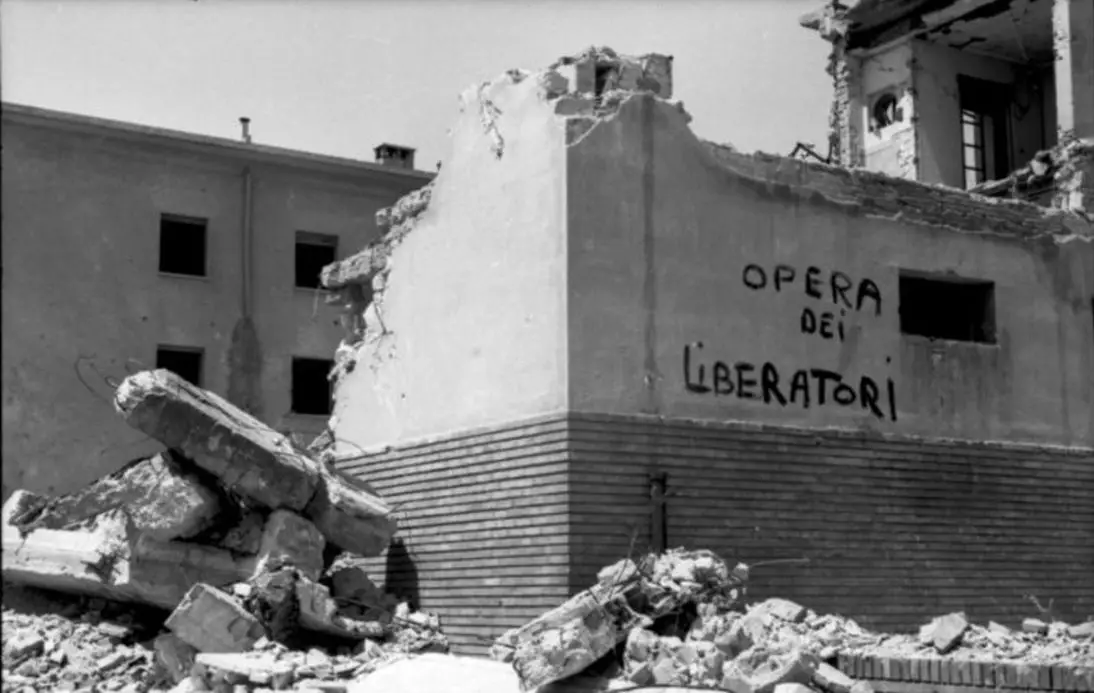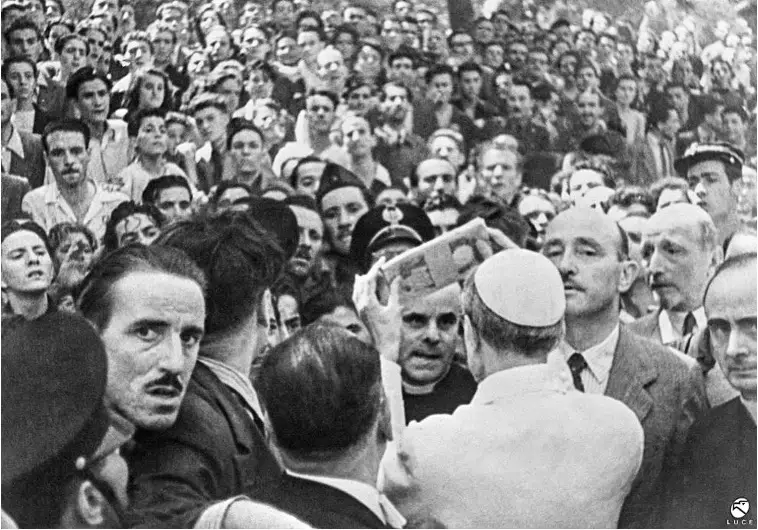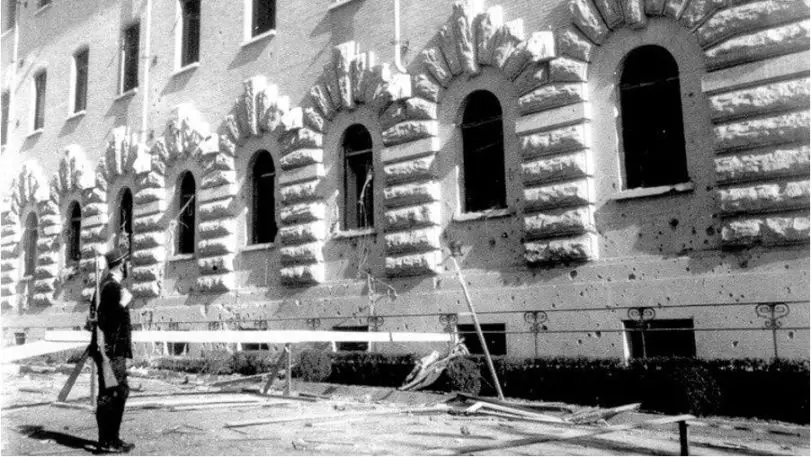World War II was one of the most significant conflicts in history, with major powers fighting across continents and oceans. One of the key players in this conflict was Italy, which was under the control of fascist dictator Benito Mussolini. Italy’s participation in the war brought about significant destruction, including damage to one of the world’s most iconic cities: Rome.
There has been some debate over whether or not Rome was bombed during World War II.
Some argue that the city was not targeted by the Allies because of its historical significance, while others claim that it was bombed but to a lesser extent than other cities in Italy.
In this article, we will examine the evidence and attempt to answer the question of whether Rome was bombed during World War II.

“work of the liberators”, written on the side of a destroyed house in Rome
THE BOMBING OF ROME
So, was Rome bombed during World War II? The answer is yes, but the extent of the damage was relatively minor compared to other cities in Italy. Rome was not targeted by the Allies in the same way that cities like Milan, Turin, and Genoa were. These cities were major industrial centers and were seen as key targets for Allied bombing campaigns. Rome, on the contrary, was just another major city but in the eyes of the allies, it just was a political centre, not an industrial one.
1943
The first ever bombing raid happened on the 19th of July 1943, when approximately 700 aircrafts of the USAAF flew over Rome and dropped 9.000 bombs on the city. This raid was intended to only damage the freight yard and the steel factory in the San Lorenzo district of Rome, but it also struck apartments and the Papal Basilica, killing 1500 people. Pope Pius XII himself talked beforehand with president Roosevelt about declaring Rome an open city due to its “historic value to humanity”, but it got nowhere. When the San Lorenzo bombing happened, His Sanctity visited the region affected and even donated some money.
The 2nd raid occurred on the 13th of August 1943, when 300 bombers conducted a bombing raid again on the San Lorenzo and the Scalo del Littorio, badly damaging even the surrounding districts and killing 500 civilians.
The last raid of 1943 occurred on the 28th of December 1943, when bombers from the 12th squadron of the USAAF attacked the airfields of Guidonia and Ciampino.
1944
The peace didn’t last for long, in fact the next bombardment shook Rome on the 23th of January 1944, when again bombers from the USAAF attacked the airfields of Guidonia and Centocelle.
Rome saw clear skies for 3 months, when again on the 3rd of March 1944 they went black from the smoke of the burning marshalling yards in the Tiburtino, Littorio and Ostiense region. As usual some bombs hit the nearby urban district, this time killing 400 civilians.
The bombings continued throughout the month of March, with that of the 10th which caused 200 victims and the last one on the 18th which caused 100. The one on the 18th would be the last major air raid over the city.

Pope Pius XIII gives money after the San Lorenzo Bombing
THE BOMBING OF VATICAN CITY
The Vatican, the spiritual and administrative centre of the Roman Catholic Church, has stood for centuries as a symbol of the faith and continuity of the Church, even in the face of war and turmoil. During the Second World War, the Vatican, like many other historic landmarks, was threatened by the destructive forces of war. Although the Vatican was not bombed during the war, it was not immune to the dangers of conflict.
The Vatican played an important role in the war effort, both as a diplomatic centre and as a refuge for those fleeing the violence of war, it was situated in the heart of Rome, and it was therefore vulnerable to the effects of the bombings.
Rome was bombed by the Allies in 1943, and many of the city’s historic landmarks were damaged or destroyed.
However, the Vatican was spared from the bombing, and this was largely due to the efforts of Pope Pius XII, who was determined to maintain the Vatican’s neutrality in the conflict.
Pope Pius XII was elected Pope in 1939, just a few months before the outbreak of the war. He was faced with the daunting task of leading the Church through one of the most difficult periods in its history.
The Pope was deeply committed to maintaining the neutrality of the Vatican, and he worked tirelessly to ensure that the Church remained impartial in the conflict.
One of the ways in which Pope Pius XII sought to maintain the Vatican’s neutrality was through diplomatic efforts. He used his position as the head of the Catholic Church to act as a mediator between the warring parties. He sought to use diplomacy to bring an end to the conflict, and he was instrumental in helping to broker the armistice between the Allies and Italy in 1943.
Another way in which the Vatican played a role in the war effort was through its humanitarian efforts. The Vatican was a haven for refugees fleeing the violence of the war. The Pope and the Church provided food, shelter, and other assistance to those in need. The Vatican also worked to secure the release of prisoners of war and other victims of the conflict.
Despite its efforts to remain neutral, the Vatican was not immune to the dangers of the war.
The Pope and the Church were well aware of the risks of being caught in the crossfire of the conflict. The Vatican took numerous precautions to protect itself from the violence.
For example, the Pope ordered the construction of bomb shelters beneath the Vatican, and he ordered the removal of many of the Vatican’s treasures to safe locations. Despite the precautions taken by the Vatican, there were still fears that the Holy State could be bombed.
The Allies were aware of the Vatican’s importance as a symbol of the Church and the faith of millions of people around the world.
However, the Allies were also aware of the Vatican’s neutrality, and they therefore took steps to ensure that the Vatican was not bombed.

Us troops on tanks enter Rome
WHY WAS ROME IMPORTANT DURING WW2
During World War II, Rome played a crucial role in the conflict, both strategically and culturally. While the Italian capital was not a key military objective, its capture by the Allies in 1944 had a significant impact on the course of the war and on the world’s perception of it.
Strategically, Rome served as a hub for transportation and communication. It was the centre of the Italian railway network and the location of the Vatican, which served as a vital channel for communication between the Allies and the Axis powers.
The capture of Rome by the Allies on June 4, 1944, helped to cut off Axis communications and transportation lines and paved the way for the invasion of northern Italy. However, the importance of Rome during World War II goes beyond its strategic value.
Rome was also a cultural symbol that represented the history and heritage of Western civilization. For centuries, Rome had been considered the centre of the world and the seat of the Roman Catholic Church. The city’s cultural importance was recognized by both the Allies and the Axis powers, who sought to use Rome’s cultural heritage to legitimize their respective causes.
During the war, Axis powers sought to portray themselves as the heirs to Rome’s cultural legacy. Mussolini’s regime used the city’s ancient architecture and monuments to celebrate the glory of the Roman Empire and the fascist movement. The Allies, on the other hand, saw Rome as a symbol of freedom and democracy. The capture of Rome was seen as a symbolic victory that demonstrated the superiority of Allied culture and values.
The importance of Rome during World War II is reflected in the many battles and campaigns fought in and around the city.
The Battle of Rome, which lasted from January to June 1944, was a series of engagements between Allied and Axis forces that resulted in the capture of the city by the Allies. The battle was marked by intense fighting, with both sides suffering heavy losses.

A guard stands near the damaged side of a building in Vatican city
CONCLUSION
In conclusion, the importance of Rome during World War II cannot be overstated. The city played a crucial role in the conflict, both as a strategic target and as a cultural symbol. The capture of Rome by the Allies helped to pave the way for the defeat of the Axis powers and demonstrated the importance of cultural heritage in shaping the course of history.
The bombing of Rome could have been avoided, but many viewed it at the same level as the bombing of Tokyo: it’s only purpose was to destabilize the population and demolish its spirit of fighting, and this worked well in Italy, since Mussolini regime fell shortly thereafter.
While the city itself didn’t suffer much as Milan or Turin or Genoa, it being bombarded gave a boost to Allied troops to end the Italian campaign quickly, and it also served to the citizens of Italy as a reminder that the war which they wanted, had finally come to their doorstep.
